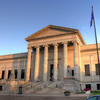More about What is an American?

Contributor
As a Sqelix’u (Salish) member of the Confederated Salish and Kootenai Nation in Montana, Jaune Quick-to-See Smith devotes much of her work to the position of Native Americans and women in contemporary society, and What is an American? is certainly no exception.
The closer you look at What is an American, the more you see. In the collaged background, there are all kinds of Easter eggs. There's mages of pineapples, a Mickey Mouse hand, Perrier, bingo sheets, phrases like “Americans have big ideas,” “Downloading your body,” “Profit Margin,” “Shopping,” and a cartoon saying: “All my life I’ve wanted to be someone. Now, who was it?”
At the heart of the piece though, Quick-to-See Smith brings up the subject of war. In World War II, Native Americans had far and away the highest rate of voluntary enlistment of any other group of people. Here, the Native American figure literally bleeds red, white, and blue over the words “What is an American?", symbolizing these soldiers' sacrifice for a country that has not treated them kindly, to say the least. The Victoria and Albert Museum in London, who also owns an edition of this print, remarks on the contemporary context, as well: "Made in the wake of the September 11 attacks on the USA, the work questions the patriotism exhibited by many Americans at this time. Claiming the right not to be violated by invaders and aggressors, they had apparently forgotten past violations of Native America."
At the Minneapolis Institute of Arts, this painting hangs next to a tipi cover by Hé Nùnpa Waníca, or Joseph No Two Horns, painted around 1915. Joseph No Two Horns was a Hunkpapa Lakota warrior who fought for Sitting Bull, his chief and cousin. Joseph No Two Horns fought in the Battle of Greasy Grass during which the Lakota, Cheyenne, and Arapaho warriors combined forces to defeat General George Armstrong Custer’s army. The atrocities against the Lakota and other Plains tribes committed by Custer were egregious. Much of Joseph No Two Horns’ work is about his life as a warrior, and his work beside Quick-to-See Smith’s is one of a series of vignettes of battle. Quick-to-See Smith’s painting draws on Joseph No Two Horns’ older representations of warriors by including a pipe bag, beaded necklaces, and leggings. Both of their pieces also incorporate text.
In general, Quick-To-See Smith’s works incorporate a lot of imagery and concepts in one space. She describes her own process saying, “All of my work develops into a series with research, reading, and traveling--an ongoing process that stimulates ideas.” Considered a part of the American modernist movement, she is linked to the abstract painters that preceded her like Wassily Kandinsky, Paul Klee, and Willem de Kooning. She remarks on these comparisons by simply saying, “Mixing abstraction with tribal motifs is hardly new, but it is a better way to communicate with a greater number of people.”
Sources
- “American Indian War Effort in World War II Is Remarkable - Timeline - Native Voices.” U.S. National Library of Medicine. National Institutes of Health. Accessed July 23, 2020. https://www.nlm.nih.gov/nativevoices/timeline/461.html.
- Ferber, Andrea L. “Salish/Métis/Cree/Shoshone-Bannock Cultural Arts Worker: Jaune Quick-To-See Smith.” First American Art, 2020. https://www.academia.edu/42770512/Salish_M%C3%A9tis_Cree_Shoshone-Banno….
- Hammond, Harmony. “Jaune Quick-to-See Smith.” ARTnews.com. ARTnews.com, September 3, 2013. https://www.artnews.com/art-in-america/aia-reviews/jaune-quick-to-see-s….
- Kastner, Carolyn. “Chapter One Born in the USA.” In Jaune Quick-to-See Smith: An American Modernist, 12–12. University of New Mexico Press, 2013.
- Lewis, Richard, and Thomas Minckler on May 29. “The Horse from the Battle of Little Big Horn.” Lewis Art Café, June 11, 2015. http://lewisartcafe.com/the-horse-from-the-battle-of-little-big-horn/.
- “What Is an American?, Jaune Quick-to-See Smith; Publisher: Brodsky Center, New Brunswick, N.J. ^ Minneapolis Institute of Art.” Accessed July 23, 2020. https://collections.artsmia.org/art/112159/what-is-an-american-jaune-qu….
- "What is an American?" Victoria and Albert Museum http://collections.vam.ac.uk/item/O120075/what-is-an-american-print-smi…











